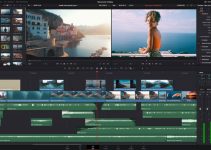Chroma Key is arguably one of the most popular video editing features to try after you master the basic post-production operations. Yet, removing green background for the first time may be challenging, especially if the footage has not been recorded by the rulebook.
The team behind VSDC Free Video Editor has recently published a beginner’s guide on working with Chroma Key, and in this guest post, they are sharing the most common mistakes happening while shooting with a green screen and how to avoid them.
It all starts with the shooting process
Truth be told, applying Chroma Key (or keying out the green color background from your video) is usually quite a no-brainer. One major factor, however, capable of giving you a hard time is the low quality of video record: poor light, unevenly green background, color interference.
So, if you’re a DIY person and decided to shoot a green screen video from scratch using improvised materials, there are few tweaks you should know about before starting. After all, a decent quality footage is already half the battle.
Make sure the background surface is evenly coated
Typically, people use a green cardboard screen or a large piece of fabric. Some order pre-made foldable screens online. Yet, you can literally utilize anything as long as it creates a solid even background: walls, pulpboard, green construction paper – what have you.
Avoiding multiple color shades is particularly important because if you don’t, it will take you more time and effort to remove the background from the video. In other words, you’ll have to key out every shade of green individually – versus just clicking once to remove a solid color screen. That said, make sure there are no noticeable stains, wrinkles, and heavy shadows on the background which might be visible in the scene.
Take time to arrange the light
Speaking of shadows, light is a crucial element when it comes to shooting green screen videos. Of course, one can argue, it is a dominant factor in any shooting, and that’s true. Yet, in this case, you should be equally careful with lightning the object and the background at the same time.
You might want to have at least 1 source of light on each side, ideally placed slightly above the object and directed to the center of the scene. Your goal is to lit the background as evenly as possible. If there is a chance to add another light to the background alone, it will help you get rid of the shadows for the most part.
Oftentimes, finding the right spot for the scene object or a person you’re shooting is an arduous task. This is why it’s essential to have enough space between the green screen and the camera – so you could experiment with maneuvering. If the object is too close to the background, there will be a thick shadow.
You’ll be able to resolve this issue by creating more space between the green screen and the scene object or using additional spotlights. Besides, as you direct the rays of light to the center, you can try to create an overlap so that the object shadow appears out of the scene.
Be smart about what you wear
Common sense dictates you should neither wear green clothes for the shooting nor have green accessories or even items containing green elements if you’re going to be on camera. Unless, of course, having a transparent body part is your idea in the first place (which is quite an eye-catching effect by the way – just google “why you can’t wear green on the green screen” to see how it looks).
You can also check out the tutorial on how to achieve a “transparent T-shirt” effect above, but if this is not the outcome you’re looking for, it is recommended to pick any other color that will contrast with your background.
Feel free to choose between green and blue screens
We wrote about it last year, and the truth is, there is no reason to overthink the choice between the green screen and the blue screen. Practically any video editing software with the Chroma Key feature will be able to cope with both colors. The only factor you should have in mind is the colors of your foreground – especially the inevitable details such as bright eye color/contact lenses or secondary elements required to appear in the frame.
In other words, if you’re shooting a St. Patrick’s Day greeting, clearly, you should use a blue screen.
As a rule of thumb, the color of your background should be as far away as possible from the colors found on the actor, otherwise keying it out and not removing anything else accidentally will be a serious challenge.
Green screen troubleshooting in VSDC
Now, even if you work with a competently recorded video, you may face few issues while applying Chroma Key. Perhaps, the most frequent one is a so-called “spill”. Edge spill looks like a green light border around the scene object and stays visible even after you’ve removed the background entirely.
It happens as the result of the green light being reflected by some parts of the foreground, or the object surface. You may see it especially often if you’re shooting someone with blonde hair or when there are numerous highlights on the scene object – the green easily bounces to those.
To get rid of this unwanted border, all you need to do is adjust the color balance. Some professional video editing software – such as Adobe After Effects – has a built-in spill suppressor and also works with 3rd-party plug-ins built for this purpose. If you happen to work with the free video editor from VSDC, you can achieve the desired result by changing the minimum brightness and chromaticity thresholds.
Notice, how just a little tweak of two parameters changes the whole picture. You’re free to play with the rest of the settings, yet, for someone just getting familiar with Chroma Key, the combination of these two should become a great helper. And remember to adjust properties once again after replacing the background with an image or a video – you can often enhance the result even more.
Afterword
Knowing how to work with the green screen is a valuable skill for a video editing enthusiast to have. Once you get a hold on that, it will take your post-production game to a new level where only your imagination may set the limit. There is at least a dozen of decent video editors providing the Chroma Key feature, and VSDC is probably a good choice if you are looking for a zero-cost solution running on Windows.
The free version of their video editor allows you to work with screens of green color only, while the PRO license worth $19 per year provides a multicolor Chroma Key tool. If you’re on Mac and want to try working with green screen, iMovie has a powerful background remover, so look no further.
[source: VSDC]
Disclaimer: As an Amazon Associate partner and participant in B&H and Adorama Affiliate programmes, we earn a small comission from each purchase made through the affiliate links listed above at no additional cost to you.



